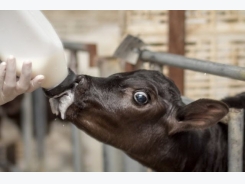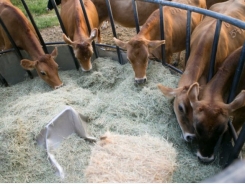Suppressing key gene may improve plant digestion

"Significant breakthrough" makes grasses more digestible, promising improved feed for ruminants and better biomass for biofuels.
Plant biomass contains considerable caloric value, but most of it makes up robust cell walls -- an unappetizing evolutionary advantage that helped grasses survive foragers and prosper for more than 60 million years. The trouble is that this robustness still makes them less digestible in the rumen of cattle and sheep and difficult to process in bioenergy refineries for fuel ethanol.
Now, a multinational team of researchers from the U.K., Brazil and the U.S. has pinpointed a gene involved in the stiffening of cell walls, and suppression of this gene increased the release of sugars by up to 60%. Their findings were reported in New Phytologist.
"The impact is potentially global as every country uses grass crops to feed animals, and several biofuel plants around the world use this feedstock," said Rowan Mitchell, a plant biologist at Rothamsted Research in the U.K. and co-leader of the team.
"In Brazil alone, the potential markets for this technology were valued last year at 1.300 billion reals ($400 million, U.S.) for biofuels and 61 million reals for forage cattle," said the other co-leader, Hugo Molinari, principal investigator of the Laboratory of Genetics & Biotechnology at Embrapa Agroenergy, part of the Brazilian Agricultural Research Corp. (Embrapa).
Billions of metric tons of biomass from grass crops are produced every year, Mitchell noted, and a key trait is its digestibility, which determines how economic the biomass is for producing biofuels and how nutritious it is for animals. Increased cell wall stiffening, or feruloylation, reduces digestibility.
"We identified grass-specific genes as candidates for controlling cell wall feruloylation 10 years ago, but it has proved very difficult to demonstrate this role, although many labs have tried," Mitchell explained. "We now provide the first strong evidence for one of these genes."
In the team's genetically modified plants, a transgene suppresses the endogenous gene responsible for feruloylation to around 20% of its normal activity. In this way, the biomass produced is less feruloylated than it would otherwise be in an unmodified plant.
"The suppression has no obvious effect on the plant's biomass production or on the appearance of the transgenic plants with lower feruloylation," Mitchell noted. "Scientifically, we now want to find out how the gene mediates feruloylation. In that way, we can see if we can make the process even more efficient."
The findings may be a boon to Brazil, where ethanol is produced from the non-food leftovers of other grass crops, such as corn stover and sugarcane residues, and from sugarcane grown as a dedicated energy crop. Increased efficiency of bio-ethanol production will help it replace fossil fuels and reduce greenhouse gas emissions.
"Economically and environmentally, our livestock industry will benefit from more efficient foraging, and our biofuels industry will benefit from biomass that needs fewer artificial enzymes to break it down during the hydrolysis process," Molinari said.
For co-author John Ralph, a University of Wisconsin-Madison professor of biochemistry who is also with the U.S. Department of Energy's Great Lakes Bioenergy Research Center, the discovery has been hard won and is long overdue.
"Various research groups 'had the feruloylation protein/gene imminently,' and that was some 20 years ago," Ralph noted. "Our group has been interested since the early 1990s in ferulate cross-linking in plant cell walls and developed the NMR (nuclear magnetic resonance) methods that were useful in the characterization here. This has been a tough one to discover."
Có thể bạn quan tâm
Phần mềm

Phối trộn thức ăn chăn nuôi

Pha dung dịch thủy canh

Định mức cho tôm ăn

Phối trộn phân bón NPK

Xác định tỷ lệ tôm sống

Chuyển đổi đơn vị phân bón

Xác định công suất sục khí

Chuyển đổi đơn vị tôm

Tính diện tích nhà kính

Tính thể tích ao hồ




 What makes a more feed efficient dairy cow?
What makes a more feed efficient dairy cow?  Volatile fatty acids boosts calf growth, rumen development
Volatile fatty acids boosts calf growth, rumen development